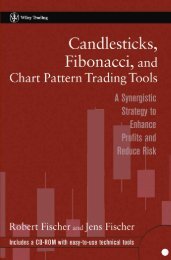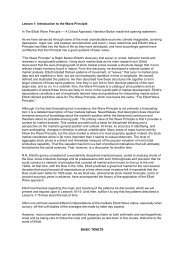The Ultimate Technical Analysis Handbook - Tradingportalen.com
The Ultimate Technical Analysis Handbook - Tradingportalen.com
The Ultimate Technical Analysis Handbook - Tradingportalen.com
Create successful ePaper yourself
Turn your PDF publications into a flip-book with our unique Google optimized e-Paper software.
Chapter 4 — Origins and Applications of the Fibonacci Sequence<br />
In addition to recognizing that the stock market undulates in repetitive patterns, R. N. Elliott also realized the<br />
importance of the Fibonacci ratio. In Elliott’s final book, Nature’s Law, he specifically referred to the Fibonacci<br />
sequence as the mathematical basis for the Wave Principle. Thanks to his discoveries, we use the Fibonacci<br />
ratio in calculating wave retracements and projections today.<br />
1. How To Identify Fibonacci Retracements<br />
<strong>The</strong> primary Fibonacci ratios that I use in identifying wave retracements are .236, .382, .500, .618 and .786.<br />
Some of you might say that .500 and .786 are not Fibonacci ratios; well, it’s all in the math. If you divide the<br />
second month of Leonardo’s rabbit example by the third month, the answer is .500, 1 divided by 2; .786 is<br />
simply the square root of .618.<br />
<strong>The</strong>re are many different Fibonacci ratios used to determine retracement levels. <strong>The</strong> most <strong>com</strong>mon are .382 and<br />
.618. However, .472, .764 and .707 are also popular choices. <strong>The</strong> decision to use a certain level is a personal<br />
choice. What you continue to use will be determined by the markets.<br />
<strong>The</strong> ac<strong>com</strong>panying charts demonstrate the relevance of .236, .382, .500 .618 and .786. It’s worth noting that<br />
Fibonacci retracements can be used on any time frame to identify potential reversal points. An important aspect<br />
to remember is that a Fibonacci retracement of a previous wave on a weekly chart is more significant than what<br />
you would find on a 60-minute chart.<br />
With five chances, there are not many things I couldn’t ac<strong>com</strong>plish. Likewise, with five retracement levels,<br />
there won’t be many pullbacks that I’ll miss. So how do you use Fibonacci retracements in the real world,<br />
when you’re trading? Do you buy or sell a .382 retracement or wait for a test of the .618 level, only to realize<br />
that prices reversed at the .500 level?<br />
<strong>The</strong> Elliott Wave Principle provides us with a framework that allows us to focus on certain levels at certain<br />
times. For example, the most <strong>com</strong>mon retracements for waves two, B and X are .500 or .618 of the previous<br />
wave. Wave four typically ends at or near a .382 retracement of the prior third wave that it is correcting.<br />
In addition to the above guidelines, I<br />
have <strong>com</strong>e up with a few of my own over<br />
the past 10 years. <strong>The</strong> first is that the best<br />
third waves originate from deep second<br />
waves. In the wave two position, I like<br />
to see a test of the .618 retracement of<br />
wave one or even .786. Chances are that<br />
a shallower wave two is actually a B or<br />
an X wave. In the fourth-wave position, I<br />
find the most <strong>com</strong>mon Fibonacci retracements<br />
to be .382 or .500. On occasion,<br />
you will see wave four retrace .618 of<br />
wave three. However, when this occurs,<br />
it is often sharp and quickly reversed.<br />
My rule of thumb for fourth waves is<br />
that whatever is done in price, won’t<br />
be done in time. What I mean by this is<br />
that if wave four is time-consuming, the<br />
Figure 28<br />
<strong>The</strong> <strong>Ultimate</strong> <strong>Technical</strong> <strong>Analysis</strong> <strong>Handbook</strong> — © 2009 Elliott Wave International<br />
This ebook includes handpicked lessons from more than 200 pages of EWI’s <strong>com</strong>prehensive<br />
Trader’s Classroom Collection of eBooks. Learn more here: http://www.elliottwave.<strong>com</strong>/wave/ClubTCC<br />
20





